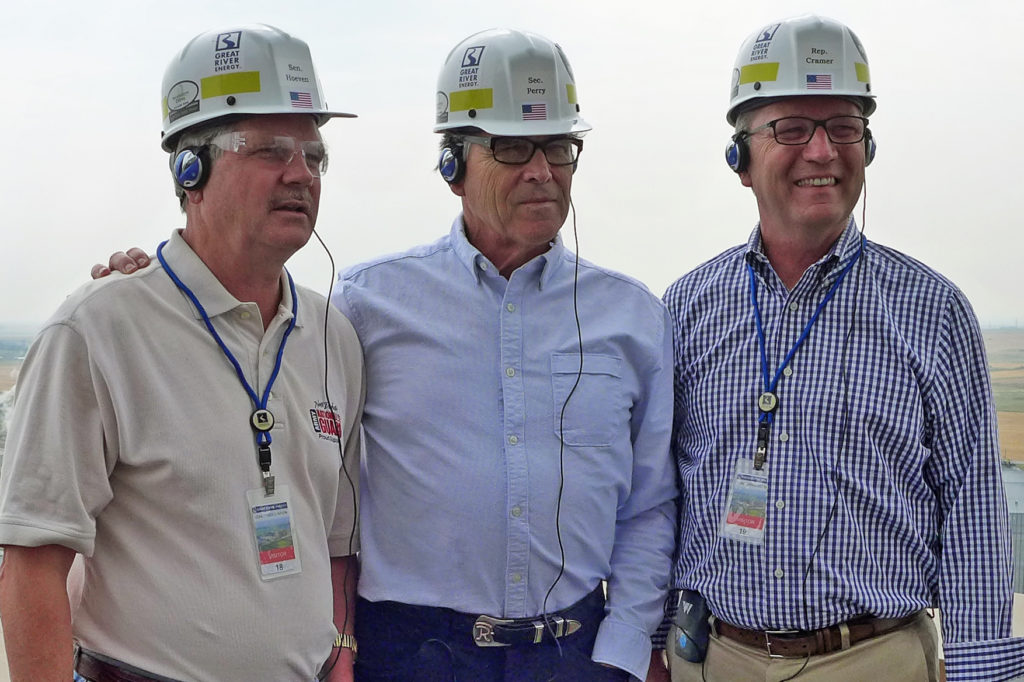
Energy Secretary Rick Perry visited one of the most productive lignite mines in the nation this week to see how the coal it produces helps power the homes and businesses of electric cooperative consumer-members.
“In this renaissance of the energy industry in America, North Dakota is right at the tip of the spear,” Perry said following a roundtable discussion with energy industry leaders on Aug. 13. “You all are playing a very, very important role in a resurgence of America on the global stage.”
Perry was in North Dakota as part of a fact-finding tour focused on modern mining processes and energy production. He visited the Falkirk Mining Company in Underwood and Great River Energy’s nearby Coal Creek Energy Park. That site includes Coal Creek Station, a 1.1-gigawatt power plant, and several facilities that use heat or steam from the plant to process or manufacture products.
“The tour was a great opportunity to share the innovative work we are doing for our member-owner cooperatives,” said Eric Olsen, general counsel for Great River Energy. The Maple Grove, Minnesota-based generation and transmission cooperative buys most of the nearly 8 million tons of lignite produced annually at the mine for use in two of its power plants.
During his visit, the secretary learned about GRE’s patented DryFining fuel enhancement system, a method of processing lignite to remove moisture and impurities, which helps stabilize the fuel, improving overall efficiency and reducing emissions.
“Making our plants more efficient is a great way to reduce carbon dioxide emissions,” said Rick Lancaster, Great River Energy’s vice president and chief generation officer. “We did this in a big way when our engineers invented and then installed DryFining technology, our patented method of drying coal and reducing emissions of mercury, nitrogen oxides, sulfur dioxide and carbon dioxide.”
While most of the lignite is used to fuel Coal Creek Station’s generators, GRE sends about 610,000 tons of the processed lignite to its Spiritwood Station, where it powers 99 megawatts of coal-based generation.
The tour, initiated by Sen. John Hoeven, R-N.D., and Rep. Kevin Cramer, R-N.D., was an opportunity for state officials to highlight the role energy production and export plays in the state’s economy.
North Dakota is second only to Texas in crude oil reserves and is home to the largest known lignite deposit in the world. It is now ranked 10th in the nation for coal production.
“Our state is an important force in advancing our nation’s energy security through our production of both traditional and renewable energy,” said Hoeven.
North Dakota Gov. Doug Burgum accompanied Perry and the state’s elected federal officials on the visit to the Falkirk mine.
“The lignite industry has invested billions of dollars to make great strides in reducing emissions while still producing three-quarters of North Dakota’s electricity,” said Burgum, noting that lignite contributes about $3 billion a year to the state’s economy.
“North Dakota and Texas prove clearly that we’re all-of-the-above energy producers,” said Perry following the tour. “We need the fossil fuels, we need the nuclear energy, we need the renewables that wind and solar bring to the table, and how we manage that in our grid is really important.”
Perry, Hoeven and Cramer agreed that affordable, reliable energy are vital to national security interests and pledged to continue to work to further exploration, production and technology advances in support of energy independence.
Derrill Holly is a staff writer at NRECA.